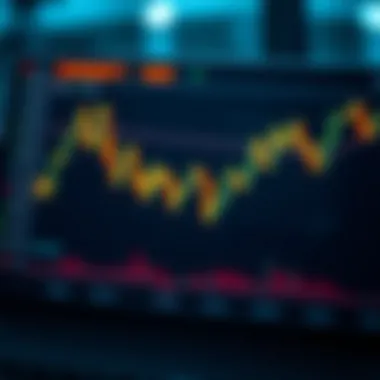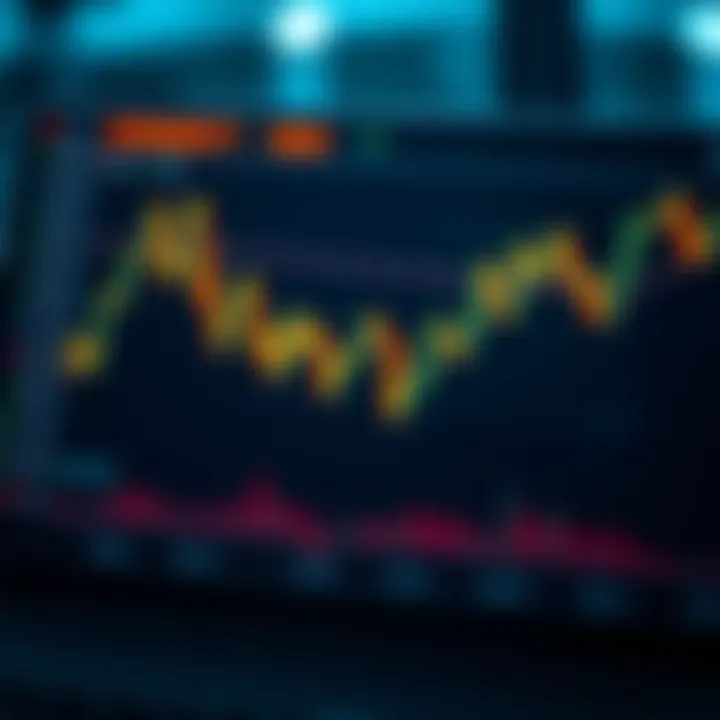Understanding the Dynamics of Commodity Selling Strategies


Intro
The world of commodity trading is a subtle yet powerful engine driving the global economy. Often viewed through a narrow lens, people miss the rich tapestry woven by the dynamics of buying and selling these essential goods. Each transaction ripples across markets, influencing prices and impacting millions of livelihoods. This article embarks on a detailed exploration of commodity selling, untangling the complex mechanisms, strategies, and implications associated with this crucial facet of financial markets.
In the following sections, we will dive into various types of commodities, dissect the market structures that support trading, and explore pricing mechanisms that determine value. We will also engage with the inherent risks that buyers and sellers face. Understanding these elements equips investors with the foresight necessary to navigate these often-turbulent waters.
As we move through the intricacies of this field, one might learn to distinguish between hard and soft commodities—raw materials like crude oil, metals, or agricultural products—and grasp the significance of understanding the commodity cycle. With historical data and current market analysis laid bare, readers will gain valuable insights that could inform their trading decisions.
Ultimately, this exploration is not merely an academic exercise; it’s about fostering a holistic grasp of commodity trading that blends knowledge with practical application.
"Understanding the forces that shape commodity prices is as essential as the commodities themselves."
Let’s begin by unpacking the essential terms and concepts that provide a foundational understanding of commodity selling.
Prelude to Commodity Selling
Commodity selling plays a crucial role in the global economy, acting as a bridge between producers and consumers while facilitating trade across borders. Understanding the dynamics of this market can provide investors and traders with significant advantages, paving their path for successful investments.
When someone talks about commodities, they’re often speaking of basic goods that are interchangeable and vital for economic functioning. These could include agricultural products like wheat or non-renewable resources like oil. In this article, we’ll explore the unique features of commodity selling and why it’s indispensable for various sectors.
Understanding Commodities
Commodities can be categorized into two main types: hard and soft. Hard commodities are typically natural resources that are mined or extracted, like crude oil and gold. Soft commodities refer to agricultural goods, such as coffee, sugar, and livestock. Each type behaves differently in the market, influenced by various factors such as seasonal cycles, weather patterns, and geopolitical tensions. This understanding is key when making trade decisions.
Many traders stay focused on price movements, supply-demand dynamics, and economic indicators to determine the best times to buy or sell. A trader’s ability to anticipate these movements often hinges on their understanding of commodities themselves. For instance, knowing that certain agricultural products may have a surplus in one season can lead to strategic buying or selling at the right time.
The Role of Commodity Markets
Commodity markets serve as the world’s financial ecosystem for buying and selling these essential goods. These markets are often divided into three primary categories: spot markets, futures markets, and over-the-counter markets. Each of these markets has its own distinct characteristics.
- Spot Markets: Here, commodities are bought and sold for immediate delivery. Prices in spot markets can fluctuate significantly based on current demand, available supply, and market sentiment.
- Futures Markets: These allow participants to speculate on the future prices of commodities. Traders enter contracts to buy or sell an asset at a predetermined price on a specific date, thus hedging against price fluctuations.
- Over-the-Counter Markets: In this decentralized market, trading happens directly between parties without a central exchange. This flexibility can lead to unique pricing mechanisms and trading strategies.
The structure of the commodity markets is integral to understanding how commodities are traded, impacting everything from pricing to risk management.
By delving into these aspects, it will become evident how commodity selling not only influences economic stability but also serves as a lucrative avenue for investors. Each market structure presents its challenges and opportunities, making it crucial for financial enthusiasts to grasp these dynamics to navigate the commodity landscape successfully.
Types of Commodities
Commodity selling is greatly influenced by the type of commodities being traded. Understanding the categories of commodities helps traders identify market trends, assess risks, and craft informed strategies. In the world of commodities, we primarily distinguish between two types: hard and soft commodities.
Hard Commodities
Hard commodities are often referred to as natural resources that are mined or extracted. These include energy commodities and metal commodities, both of which play a crucial role in the global economy.
Energy Commodities
When talking about energy commodities, we mainly refer to oil, natural gas, and coal. These resources are the backbone of industrial growth and everyday energy consumption. Their prices are often dictated by factors such as geopolitics, supply disruptions, and seasonal demand shifts. One key characteristic of energy commodities is their essential role in energy production and transportation. They are highly liquid in nature, making them a popular choice for investors seeking quicker returns.
Energy commodities are often the first to be affected by geopolitical events. For example, tensions in the Middle East can lead to significant fluctuations in crude oil prices, impacting global markets entirely.
However, the volatility of energy prices can be a double-edged sword. While investors can gain from short-term spikes, prolonged downturns can wipe out margins quickly if not managed correctly.
Metal Commodities
Metal commodities, including gold, silver, copper, and aluminum, are highly sought after by traders for various reasons. They not only serve as critical industrial inputs but also function as a hedge against inflation. Gold, particularly, is viewed as a safe haven asset during economic uncertainty.
One of the most notable features of metal commodities is their intrinsic value. Unlike many other investments, metal commodities maintain baseline worth because they are finite resources. This uniqueness can provide some security for investors. However, the market for metals can also be swayed by changes in technology and new discoveries in mining techniques, leading to unexpected price shifts.
Soft Commodities
In contrast, soft commodities are typically agricultural products or livestock. This category encompasses a range of goods such as grains, fruits, vegetables, and meat products.
Agricultural Products
Agricultural products are a cornerstone of food supply chains across the globe. With staples like wheat, corn, and soybeans at the forefront, these commodities have unique factors influencing their pricing, such as weather conditions, seasonal cycles, and changes in consumer preferences. Additionally, one of the defining characteristics is their susceptibility to environmental factors—droughts can send prices soaring, while bumper crops can drive them downward.
A compelling attribute of agricultural products is their direct link to everyday life, making them not just financial instruments, but vital commodities for sustenance. However, the volatility tied to climatic variations can make trading them quite risky, with prices swinging wildly based on harvest forecasts.
Livestock
Livestock trading includes commodities like cattle, pigs, and chickens. This segment is influenced by various factors, including feed prices, disease outbreaks, and consumer trends towards healthier eating.
Livestock can be quite attractive for investors due to their unique supply chain dynamics—meaning there are different market timings compared to crops, which can provide opportunities for strategic selling. However, managing the risks associated with livestock can be complex. Fluctuations caused by health concerns (like an outbreak of swine flu) can significantly impact prices and extend far beyond mere market trends.


Market Structures
Understanding the various market structures is crucial for anyone engaging with commodities, as they dictate how trades are executed and influence pricing dynamics. These structures offer insights on liquidity, volatility, and the behaviors of buyers and sellers in the commodity marketplace. Each market type serves its unique purpose and comes with its own set of benefits and considerations that traders should carefully weigh.
Spot Markets
Spot markets represent the proverbial fast lane in commodity trading. Here, transactions occur for immediate delivery of the asset involved. When a trader purchases oil on a spot market, this isn't some distant future deal; it's a transaction that finalizes almost instantaneously—think of it as paying cash for groceries rather than putting it on credit.
One of the standout features of spot markets is their transparency. The pricing is straightforward, reflecting real-time supply and demand dynamics. Buyers can expect quick access to commodities, and sellers can generate immediate cash flow. However, this speed comes with its own risks. Prices can fluctuate wildly based on current events, affecting trading strategies and decisions.
For example, if news breaks that a major oil pipeline has shut down, traders in the spot market may find prices soaring in a matter of moments. Such rapid changes can lead to both lucrative trades and significant losses, depending on one’s ability to recognize and react to market shifts.
Futures Markets
Futures markets, in contrast, play the long game. Here, contracts are signed for the future delivery of commodities at a predetermined price. This structure allows traders to hedge against price fluctuations. Imagine you run a bakery; signing a futures contract for flour at today’s prices shields you from any potential price hike down the line. It’s a strategic move often embraced by those looking to secure consistent operational costs.
On another note, futures trading can amplify risks. If the market swings unfavorable, the trader might end up locked into a contract that results in losses rather than gains. Notably, futures markets facilitate speculative trading; investors often engage in buying and selling contracts without any intent of taking delivery of the actual commodities. This speculation can increase liquidity, but it can also inject volatility into the market.
Over-the-Counter Markets
Over-the-counter (OTC) markets offer perhaps the most flexible trading environment among the three structures. Here, transactions occur directly between parties, without a centralized exchange. Think of it as doing business in a bartering manner; the terms are negotiated on a deal-by-deal basis.
The OTC market caters to customized needs. If a trader requires a specific quantity of a commodity, such as a rare type of coffee, they can negotiate an agreement that perfectly meets their requirements. This non-standardization, however, comes with inherent risks. Since these transactions lack the oversight of regulated exchanges, transparency can suffer, leading to potential disputes.
In summary, market structures play pivotal roles in commodity trading. Understanding their distinct characteristics allows traders to develop informed strategies, mitigate risks, and seize opportunities effectively.
Every type of market has its advantages and drawbacks, and savvy traders know how to navigate these intricate waters. Whether they’re leveraging the immediacy of spot markets, hedging in futures, or making bespoke arrangements in OTC markets, knowledge of these frameworks is essential for successful commodity selling.
Pricing Mechanisms
Understanding the pricing mechanisms of commodities is crucial for buyers and sellers in the market. These mechanisms form the backbone of transactions and can significantly affect profitability, risk management, and overall market stability. The price of a commodity does not just emerge out of thin air; it is the result of complex interactions among various factors that include supply and demand, market speculation, global economic conditions, and geopolitical events.
Price Determinants for Commodities
Supply and Demand Factors
At the heart of pricing mechanisms lie supply and demand factors. Simply put, when supply exceeds demand, prices tend to drop; conversely, when demand outstrips supply, prices usually rise. This model is often viewed as the fundamental law of economics, shaping the pricing landscape for commodities. For instance, during a drought, the supply of agricultural products like wheat can diminish, leading to increased prices as buyers compete for fewer resources.
One key characteristic of supply and demand factors is their inherent volatility. This characteristic makes them both a prominent and a precarious choice for traders and investors alike. Though easy to grasp, these factors can also produce erratic price swings—making them a double-edged sword in decision-making processes. A unique feature is the lag time between the emergence of economic signals and market reactions, which can catch even seasoned traders off guard.
The advantages of understanding these factors are numerous. They allow for better forecasting and strategic planning. On the flip side, the disadvantages include the inherent unpredictability of consumer behavior and external shocks, which can lead to rapid changes that are difficult to anticipate.
Global Economic Indicators
Global economic indicators serve as another essential cog in the wheel of pricing mechanisms. These indicators, which encompass a range of data from GDP growth rates to unemployment figures, offer insights into the overall health of economies around the world. For traders in the commodity space, keeping an eye on such indicators is crucial because they directly influence demand and supply dynamics.
A notable characteristic of global economic indicators is their ability to offer macro-level perspectives. This enables traders to gauge potential shifts in market sentiment and buyer behavior. For example, an uptick in manufacturing output in a major economy might increase demand for base metals like copper, thereby pushing prices higher.
The unique feature of these indicators is their reflective nature; they reveal not just current conditions but also future trends. However, the disadvantages lie in the time it takes to interpret and act on this data, as well as the possibility of data being misreported or misinterpreted.
Role of Speculation
Speculation occupies a significant role in commodity pricing. Traders engage in speculation when they purchase commodities not for immediate use, but with the expectation that prices will rise. This behavior can act as both a stabilizing influence and a source of volatility. Speculators can provide liquidity to the market, which in turn can tighten spreads and make trading easier for all participants. Nevertheless, it's important to approach speculation with caution since it can lead to exaggerated price movements based on emotion rather than fundamentals.
Impact of Geopolitical Events
Geopolitical events wield considerable influence in the world of commodities. Developments such as conflicts, trade agreements, sanctions, or natural disasters can cause immediate price fluctuations. For example, tensions in the Middle East can disrupt oil supplies, causing global prices to soar. The interconnectedness of markets means that one event can have ripple effects across various sectors.
Understanding these impacts provides valuable context for pricing mechanics. While they can present risks, they also create opportunities for informed trading strategies. However, caution is advised; geopolitical events can introduce uncertainty that complicates pricing predictions, risking potential losses for those caught off guard.
In summary, pricing mechanisms in commodity trading emerge from a complex network of supply and demand dynamics, economic indicators, speculative behavior, and geopolitical influences. Understanding these elements can significantly enhance decision-making and strategic planning for traders.
For a deeper dive into commodities and their pricing mechanisms, consider visiting Investopedia or World Bank for more insights.
Risk Factors in Commodity Selling
In the world of commodity selling, understanding the risk factors is not just optional, it's essential. Risks can greatly influence market dynamics and decision-making processes. A trader who has their ears to the ground on these issues not only survives but thrives. These factors vary widely, so let’s crack open the nuances of market, credit, and operational risks.
Market Risks
Market risks in commodity trading hinge on fluctuations in prices due to supply and demand shifts. Think about if there’s a sudden frost that devastates a corn crop; suddenly, corn prices might skyrocket. On the flip side, if a new energy source emerges that makes fossil fuels less desirable, the values of oil and gas might tumble overnight.
Several forces can drive these market risks:
- Global economic trends: Economic growth in one country might mean increased demand for raw materials.
- Political stability: Countries embroiled in strife can severely influence commodity values.
- Regulatory changes: Fresh legislation can alter the landscape significantly.


Understanding these elements is crucial for any trader looking to get a solid footing in the market.
Credit Risks
When you’re diving into commodity transactions, credit risks lurk just beneath the surface. This risk comes from the possibility of a counterparty failing to fulfill their contractual obligations. Imagine a buyer who promises to pay for a shipment of copper, but when the time comes, they can't scrape together the cash. This situation can prompt serious financial losses for the seller.
Mitigating credit risks involves:
- Thorough due diligence: Always examine your client’s financial stability.
- Utilizing credit reports: These can help gauge the reliability of potential partners.
- Transaction insurance: Some firms opt for credit insurance to shield themselves against default risks.
These tactics may seem like a hassle, but when the stakes are high, they pay off.
Operational Risks
Operational risks encompass the day-to-day hazards that can disrupt trading activities. These can arise from a multitude of sources including internal processes, systems failures, or even human error. An example could be a glitch in inventory management systems leading to significant over or under-commitments in sales. Such blunders can drain your resources and tarnish your reputation.
Here are pertinent factors affecting operational risks:
- Supply chain disruptions: A natural disaster can halt production and alter supply levels.
- Technological failures: Outdated methods or software might not keep pace with market demands.
- Regulatory challenges: Failing to comply with laws can result in hefty fines.
To guard against operational risks, fostering robust internal controls and regular employee training can be genuine game-changers.
"A stitch in time saves nine." Understanding these risk factors and having plans in place is not just smart; it's necessary for sustainability in commodity selling.
Given the unpredictable nature of commodity markets, knowing these risk factors can separate successful traders from those left in the dust. Each risk, be it market, credit, or operational, poses challenges but with the right knowledge and strategy, it’s possible to navigate these stormy seas.
Strategies for Successful Commodity Selling
In the ever-evolving landscape of commodity trading, having robust strategies can be the difference between a thriving business and a troubled one. It's not just about buying low and selling high anymore. The dynamics of commodity selling demand a nuanced understanding of the market, risk management, and innovative approaches to securing profits. This section will delve into diversified strategies, hedging techniques, and the application of technical analysis, all tailored for savvy investors and traders looking to stay ahead of the curve.
Diversification Strategies
One of the cornerstone strategies in commodity trading is diversification. By spreading investments across various commodities, sellers can significantly mitigate risk. Imagine a farmer who only grows corn; if a drought hits, they could face severe losses. However, if that same farmer also cultivates soybeans, they might cushion their losses with a better harvest in a complementary crop.
The rationale behind diversification involves several layers of consideration:
- Reduced Volatility: By not putting all eggs in one basket, traders can ride out the ups and downs of individual commodities.
- Access to Different Markets: Different commodities have unique market cycles. Staying engaged with various commodities can help traders take advantage of various economic conditions.
- Relationship Management: Diversifying can mean establishing relationships with multiple suppliers and buyers, thereby increasing the potential for better pricing and availability.
For instance, an investor focused solely on precious metals might miss the boat when agricultural commodities surge due to favorable weather patterns. Diversification, therefore, isn’t just a hedge against risk; it's a strategic tool to enhance overall returns.
Hedging Techniques
Hedging is akin to wearing a raincoat on a cloudy day; you hope you don't need it, but if the storm comes, you're grateful it's there. In commodity selling, hedging serves as a protective shield against unfavorable price movements. Various instruments exist to implement hedging, including futures contracts and options.
Here’s a closer look at popular hedging techniques:
- Futures Contracts: By entering a futures contract, a seller can lock in prices for commodities at a future date. This is especially useful in volatile markets where price fluctuations can erode profit margins.
- Options Trading: Options provide sellers with the right, but not the obligation, to buy or sell a commodity at a predetermined price. This flexibility can be particularly useful for managing risk while still allowing room for profit.
- Cross-Hedging: Sometimes, it makes sense to hedge with correlated commodities. For example, a trader dealing in oil might look at natural gas prices due to their historical correlation.
Using these tools effectively requires an understanding of market conditions and a keen sense of timing.
Using Technical Analysis
Relying on gut feelings can lead to poor decisions in commodity trading. Instead, employing technical analysis can provide traders with a data-driven approach to spotting trends and predicting market movements. The basics involve examining historical price charts and identifying patterns that repeat over time.
Consider these critical elements of technical analysis:
- Chart Patterns: Recognizing triangles, head-and-shoulders, or other forms can predict potential price movements. For instance, a rising triangle might suggest a bullish breakout, signaling a buying opportunity.
- Indicators: Tools like the Relative Strength Index (RSI) or moving averages help traders quantify whether a commodity is overbought or oversold. By using indicators, traders can determine optimal entry and exit points.
- Volume Analysis: Analyzing trading volume alongside price movements can provide insights into the strength of a trend. High volume on an upward price movement might indicate strong buyer interest and continued price appreciation.
Ultimately, the application of technical analysis in commodity trading is about giving oneself an edge. It’s like having directions on a map—the clearer the path, the better the odds of reaching your destination successfully.
"Success in commodity selling goes beyond basic buying and selling; it’s about crafting a strategy that understands and adapts to the shifting tides of the market."
Technological Advancements in Commodity Trading
Technological innovations have dramatically changed the landscape of commodity trading. Traders and investors, equipped with advanced tools, can now navigate these intricate markets with greater efficiency and accuracy. Understanding these advancements is essential for anyone interested in commodity selling, as they present both opportunities and challenges that shape trading dynamics.
Advantages of Technology in Commodity Trading
With the growth of technology, commodity trading has become more accessible. Investors can now rely on various platforms for real-time information, market analysis, and trading execution. These advantages include:
- Speed and Efficiency: Automation allows for faster execution of trades, reducing the time spent on manual processes.
- Data Analysis: Algorithms analyze vast amounts of data to assist traders in making informed decisions based on historical patterns and current market conditions.
- Reduced Costs: Technological solutions often streamline operations, leading to lower transaction costs.
Despite these benefits, technology also introduces certain complexities, such as ensuring data security and managing the risks associated with algorithmic trading.
Algorithmic Trading
Algorithmic trading is one of the most prominent technological advancements in commodity markets. This method uses computer programs to analyze market data and execute trades automatically based on predefined criteria. It operates on the principle of efficiency – speed is of the essence, and algorithmic trading can execute trades within milliseconds, capitalizing on fleeting market opportunities that human traders might miss.


Key Aspects of Algorithmic Trading
Here are a few noteworthy features that make algorithmic trading appealing:
- Market Liquidity: It enhances liquidity in the market since algorithms operate continuously, buying and selling based on conditions preset by the trader.
- Access to Advanced Strategies: Algorithms can incorporate complex strategies that would normally be difficult for human traders to execute consistently.
- Reduced Emotional Bias: By adhering to a specific set of rules, algorithmic trading can help mitigate emotional decision-making, which often leads to poor investment choices.
However, traders must remain mindful of the errors that can arise from technology. A technical glitch, for instance, could trigger unintended trades, leading to significant losses.
Blockchain's Influence
The emergence of blockchain technology has made waves across various industries, and commodity trading is no exception. Blockchain's key feature is its ability to provide secure, transparent, and immutable records of transactions, which can enhance the traceability of commodities from production to consumption.
Impact of Blockchain on Commodity Trading
Its influence can be observed in several areas:
- Improved Transparency: Blockchain allows all parties involved to access the same transaction history, significantly reducing the risk of fraud and disputes.
- Enhanced Supply Chain Management: This technology enables better tracking and verification of goods, leading to more efficient operations across the supply chain.
- Smart Contracts: These self-executing contracts, written into code on the blockchain, can automate processes, making transactions quicker and reducing reliance on intermediaries.
Despite its promise, the implementation of blockchain technology also comes with challenges, such as regulatory barriers and the need for widespread industry acceptance.
"Blockchain technology, while still in its infancy in commodity trading, holds the potential to transform how transactions are executed and recorded, paving the way for increased efficiency and trust in market interactions."
In summary, technological advancements are reshaping commodity trading in profound ways. Both algorithmic trading and blockchain technology are enhancing efficiency and transparency, but they also demand careful consideration of the risks involved. Traders who embrace these innovations can better position themselves to navigate the complexities of commodity selling in the contemporary marketplace.
Sustainability Considerations
In today's world, the importance of sustainability in commodity selling cannot be overstated. The landscape is evolving, with an increasing focus on ethical practices that balance economic benefits against social responsibilities and environmental considerations. The consequences of ignoring sustainability can ripple far and wide, affecting not just the flora and fauna, but also the very market dynamics that underpin commodity selling.
Ethical Trading Practices
Ethical trading is no longer just a buzzword; it's become an essential element for businesses aiming to thrive in the modern market. When traders engage in ethical practices, they create a framework where fairness and transparency take center stage. This involves scrutinizing supply chains and ensuring that every link contributes positively to local economies.
For instance, a coffee trader who buys directly from farmers works hard to ensure fair prices and better working conditions. Not only does this build a loyal customer base, but it also enhances the overall reputation of the brand. Adding to that, adhering to ethical standards can also provide a leg up in competitive markets by differentiating a trader from others who may not prioritize such values.
"A solid ethical foundation can enhance brand reputation and customer loyalty in ways that profit margins can’t always predict."
Moreover, ethical practices extend beyond just monetary considerations; they are about respect for human rights as well. Traders should encourage practices that avoid exploitation or abuse, ensuring that commodity production doesn't come at the cost of someone's dignity.
Environmental Impacts
The environmental impacts associated with commodity selling are multifaceted and deeply consequential. As global demand for commodities continues to rise, the pressure on natural resources intensifies. The extraction and production processes can lead to severe degradation—think deforestation due to palm oil expansion or water pollution from mining activities.
To mitigate these impacts, it is crucial for traders and investors alike to advocate for sustainable practices. This means selecting suppliers who utilize environmentally-friendly methods and are committed to minimizing carbon footprints. For example, a metal trader could seek partnerships with companies that use recycled materials or renewable energy in their production processes. Not only does this support the planet, but it can also often lead to cost savings in the long run.
In fact, engaging in sustainable practices can become a unique selling proposition that appeals to increasingly eco-conscious consumers. It sets a company apart in a crowded marketplace and fosters long-term resilience by reducing dependence on finite resources.
Global Trends in Commodity Markets
Understanding global trends in commodity markets is essential for anyone involved in trading or investing. These trends not only reflect the dynamics of supply and demand but also serve as indicators of economic health across various regions. As markets become increasingly interconnected, the implications of these trends can be profound. By recognizing and adapting to the shifts in commodity markets, traders and investors can devise strategies that align with the dynamic environment.
Emerging Markets
Emerging markets play a pivotal role in the commodity landscape, often driving demand for various resources. Countries like China, India, and Brazil have seen rapid industrialization, leading to increased consumption of commodities — from metals to agricultural produce. These markets often exhibit unique characteristics that distinguish them from established economies:
- Higher Volatility: Prices in emerging markets tend to be more volatile, driven by local economic policies and changes in trade partnerships.
- Diverse Needs: Each market has specific requirements based on its developmental stage, economic structure, and cultural influences. For instance, India's need for energy resources differs significantly from Brazil's agricultural focus.
- Regulatory Environment: Traders face distinct regulatory challenges in emerging markets. Local policies can affect everything from tariffs on imports to environmental regulations.
Keeping an eye on these trends can provide traders with insights into potential opportunities and risks. By analyzing the evolving landscape of emerging markets, investors can target sectors likely to experience growth, thus making informed decisions that enhance their portfolio.
Impact of Climate Change
The impact of climate change on commodity markets cannot be overstated. As environmental concerns grow, the way commodities are produced, consumed, and traded is evolving dramatically. Here are some significant ways climate change is reshaping these markets:
- Supply Chain Disruptions: Extreme weather events can disrupt the supply chains of commodities like grains, causing scarcity and price spikes. For instance, in recent years, droughts in major agricultural regions have led to heightened concerns about food security.
- Shifts in Demand: As global awareness of sustainability increases, there's a transition toward greener alternatives. Commodities linked to fossil fuels are facing decreasing demand, while renewable resources, such as lithium for batteries, are gaining traction.
- Regulatory Changes: Governments worldwide are implementing regulations aimed at curbing emissions. These new laws can directly impact producers and influence commodity prices. For example, carbon taxes in some countries force companies to rethink their extraction methods or product lines to align with environmentally friendly practices.
"The market is always adjusting, but climate change seems to add an extra layer of unpredictability that every trader must account for."
Epilogue
In reflecting on the dynamics of commodity selling, the significance of summation emerges clear. It serves to compile a wealth of information into a digestible format, offering readers a cohesive understanding of the insights gathered. Here's a deeper look into the elements at play in this critical aspect.
Summary of Key Insights
Throughout this article, we've traversed various terrains of the commodity market. Here are the fundamental takeaways:
- Understanding Commodities: Commodities fall primarily into two categories, hard and soft, each serving different industries and consumer needs.
- Market Structures: From spot and futures to over-the-counter markets, each structure presents unique opportunities and risks.
- Pricing Mechanisms: Prices are influenced by a complex interplay of supply and demand, with additional layers such as speculation and geopolitical events having pronounced effects.
- Risk Factors: Market, credit, and operational risks shape the strategies traders must employ to safeguard their ventures.
- Strategies for Success: Employing diversification and hedging techniques not only mitigates risks but also positions traders for optimal gains.
- Technological Advancements: Innovations like algorithmic trading and blockchain are revolutionizing how commodities are traded, opening new pathways for efficiency.
- Sustainability Considerations: Ethical practices and minimizing environmental impacts are becoming integral to the way commodities are handled and traded.
These insights form a bedrock for understanding the market's nuances and guiding informed decision-making.
Future Directions in Commodity Selling
As we look ahead, commodity selling is poised to evolve significantly. Here are some potential trajectories:
- Increased Regulation: As traders operate in a landscape marked by volatility and rapid technological change, expect more stringent regulatory measures to emerge. Governments aim to ensure fair play and transparency, especially as the market globalizes.
- Sustainable Practices: With the climate crisis at the forefront, companies might prioritize sustainability in commodity sourcing and trading. This transition could reshape operational norms and consumer expectations alike.
- Technological Integration: Automation and artificial intelligence will likely play larger roles in predicting market trends and executing trades. Companies using data-driven methodologies will have a competitive edge.
- Diversification of Commodities: Investing in new commodities such as blockchain technology or digital currencies represents a shift in how goods and value are assessed in the market. This opens new pathways for investors looking to penetrate unfamiliar territory.
- Global Trade Relations: Shifts in international relations and trade agreements will impact supply chains and commodity availability. Awareness of these factors will be crucial for adept trading.
Ultimately, understanding these emerging trends will equip financial enthusiasts and investors to navigate the complexities of this ever-evolving landscape. The market is alive with possibilities, and preparedness is the key to taking advantage of upcoming changes.















